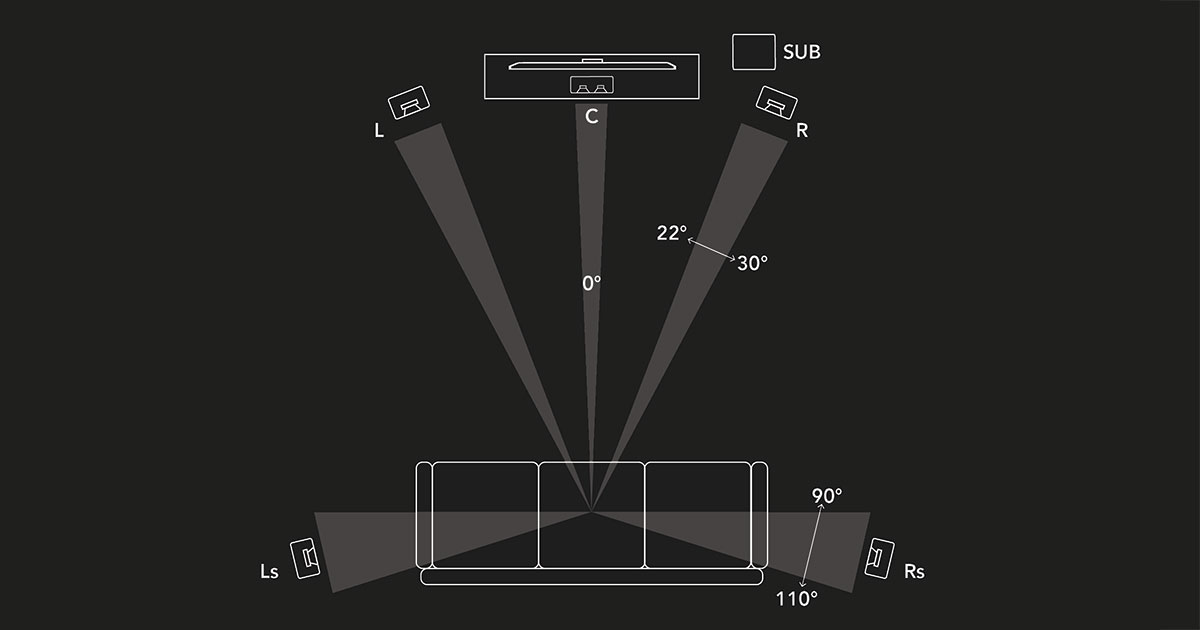Serious about surround sound? Why ceiling speakers may not be for you
Ceiling speakers are an increasingly popular option if you're serious about surround sound, but we're here to tell you there could be a better way...
Stop us if you’ve heard this one: you’ve just set up your brand new flat-screen television. You choose an episode of your favourite TV season to test it, sit back and, giddy with excitement, hit the play button. You’re expecting a mind blowing experience and it’s pretty good, but you notice something isn’t quite right. The visuals are sublime, the picture crystal clear — yet something’s missing. 10 minutes in and you suddenly get it: the sound’s pretty underwhelming. The bass is flat, it sounds a bit thin, and it’s not really loud enough where it feels like it should be.
Don’t worry; it isn't just you. This is a common feeling and there’s a pretty straight forward reason why this happens. In the manufacturer's race to make the thinnest, lightest, sleekest, and cheapest screens, something naturally has to give — and for most manufacturers it’s audio that’s first for the chop. Which brings us to the question of choosing an independent sound system that’s best for you.
So I’ll need a sound system?
When you consider that this year, LG are releasing a 1cm thick TV with no inbuilt speakers, it seems that this is the direction the market will be heading in for some time. An independent sound system will be a prerequisite to achieving suitable — or indeed any — audio reproduction. You’re not stuck though; you have plenty of options to achieve high quality sound from your lovely 4K UHD (Ultra High Definition) TV.
Traditionally, 5.1/7.1 surround-sound systems bring to mind tall speaker towers, long cable runs, and probably a dedicated home cinema to pop it all in. This seemingly elaborate method of surround-sound is still unquestionably the most consistently featured surround-sound setup.
This is partly because industry leaders Dolby and THX, among others, have guidelines and approved standards for surround systems in both professional and residential spaces. Among other things, these standards basically mimic loudspeaker placement when content is produced, mixed, and mastered before release. The idea is that consumers will have the most authentic representation of how the content being watched is supposed to sound. What it sounded like to the showrunners should be how it sounds to you.
The good news is the price for surround systems is decreasing and quality is improving as technology pushes on to more ambitious sound technologies.

But doesn’t it take up space?
The biggest deterrent to a traditional surround sound setup - besides price - is space. Particularly, finding a suitable location for the ‘Left Surround’ and ‘Right Surround’ speakers; since they should be behind you and separate sides. More often than not, unless you have a dedicated space to arrange a system. You’ll be organising your setup to fit around pre-existing and probably already efficiently placed furniture, perhaps compromising the surround sound’s effectiveness.
This does raise the issue of legitimacy of flush mounted ceiling speakers. Which do have some convenient benefits, especially if you have the DIY and audio know how, and a place you’re allowed to modify.
They’re certainly a stylish and a low profile option over speaker stands or commercial satellite speakers. They do leave you with extra floorspace which is a big plus! In terms of audio quality and choice, only particular types of in-ceiling speaker will ever yield a desirable sound for a home cinema. It’s crucial that in-ceiling speakers for this application are directional — the woofers and tweeters inside the enclosure can be pointed to a desired spot in the room.
So ceiling speakers are the obvious choice?
Well, to be honest — not necessarily. There are plenty of drawbacks that can make installing in-ceiling speakers more hassle than it’s worth. Firstly, the practical challenges: they require long cable runs that are susceptible to interference from obstructions like pipes, joists, and partitions. There’s also the issue of not knowing whether your speaker positions will yield a satisfactory result; you won’t know what they sound like until they’re installed and turned on, at which point you’re stuck with them. There could also be limitations in rearranging your living space or upgrading/replacing equipment in future. The long and short of it is that it can be risky and require a lot of investment. And that’s before we even get to the audio quality of in-ceiling systems.
So users more acquainted to a surround system, using directional in-ceiling speakers for left, right, and centre channels is often described as unnatural sounding. This is particularly the case with voices which are generally reserved for the centre channel and will be panned to match the content on screen. The effect is playfully described as the ‘voice of God’ because voices will sound as though they’re coming from above and are not synchronised with voice placement on screen.
Now, we’re not looking to scare you off ceiling speakers, but it’s certainly time consuming and yields the most potential problems, for an arguably average system. The problem is that most think they are the only alternative to the traditional surround-sound setup.
So what are my options?
There’s been a huge boom in Soundbar technologies that create a ‘surround-like’ effect. Utilising sophisticated digital signal processes (DSP) and creative speaker enclosure placement, they create a quality cinematic experience for consumers, as well as saving space, time, and money. Soundbars tackle some of the reproduction pitfalls of stereo, and to a lesser degree surround sound; namely by eliminating the importance of the user's listening position.
The listening ‘sweet spot’ in stereo is described as equidistance from both left and right loudspeaker. Too close to either one of these and the sound becomes unbalanced and creates phase issues and interaction problems between the two signals. Not ideal.

Now, not to toot our own horn, but not many products eliminate this spatial distortion effect so well as our own Airsound™ technology. This patented technology is employed in all of our latest product ranges and is a serious option for any consumer looking for a versatile home cinema/audio system; one that does so without breaking the bank or taking up too much valuable space. It works without traditional Left and Right channels and employing the use of side-firing speakers (spatial), and a dedicated centre facing (main) channel. Information is distributed between the speakers in a different way to traditional loudspeakers.

Essentially, the Main signal is the sound that both ears should be hearing in equal measure. While the Spatial signal conveys the information that positions this main signal in, well, space. When these signals project and reflect around the space, a balanced and even stereo image is created for every listener in the room; it eliminates poor quality listening positions, allowing everyone to experience the content as it’s supposed to be experienced.
Ultimately there are more solutions than ever for consumers who require a solid quality audio system to match their display. What's best for you comes down to your own needs and what you want to use the system for. However, what we do want to impress on you is this: you don’t need to upend or reconstruct your entire living room to achieve fantastic surround-sound. If you need any more information, just give us a call.





